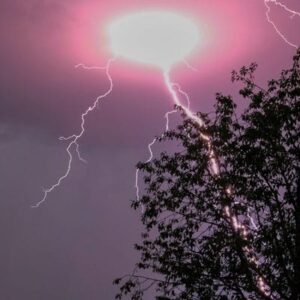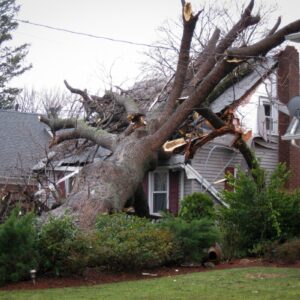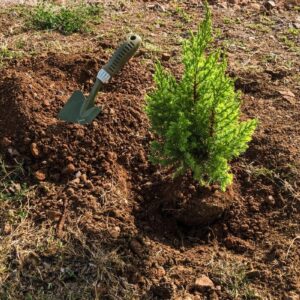Are you noticing cracks in your Massachusetts trees? Don’t ignore them! These cracks can be a sign of underlying issues that require your attention. Extreme weather conditions, such as frost, storms, and droughts, can weaken tree structures. Pests and insects can also infest trees, causing damage. Additionally, common tree diseases in Massachusetts can lead to cracking. Even human activities, like construction or improper pruning, can contribute to tree damage.
In this article, we will explore the reasons behind these cracks and provide preventive measures to maintain the health of your trees.
Key Takeaways
- Extreme weather conditions such as storms, wind pressure, freezing temperatures, and heavy rain can cause cracks in Massachusetts trees.
- Infestations by pests and insects, including boring insects and sap-sucking pests, can weaken trees and lead to cracks.
- Common tree diseases in Massachusetts, such as Dutch elm disease, oak wilt, and beech bark disease, can cause tree cracking and mortality.
- Human activities, such as improper pruning, construction and excavation work, and the use of herbicides and pesticides, can also contribute to tree damage and cracks.
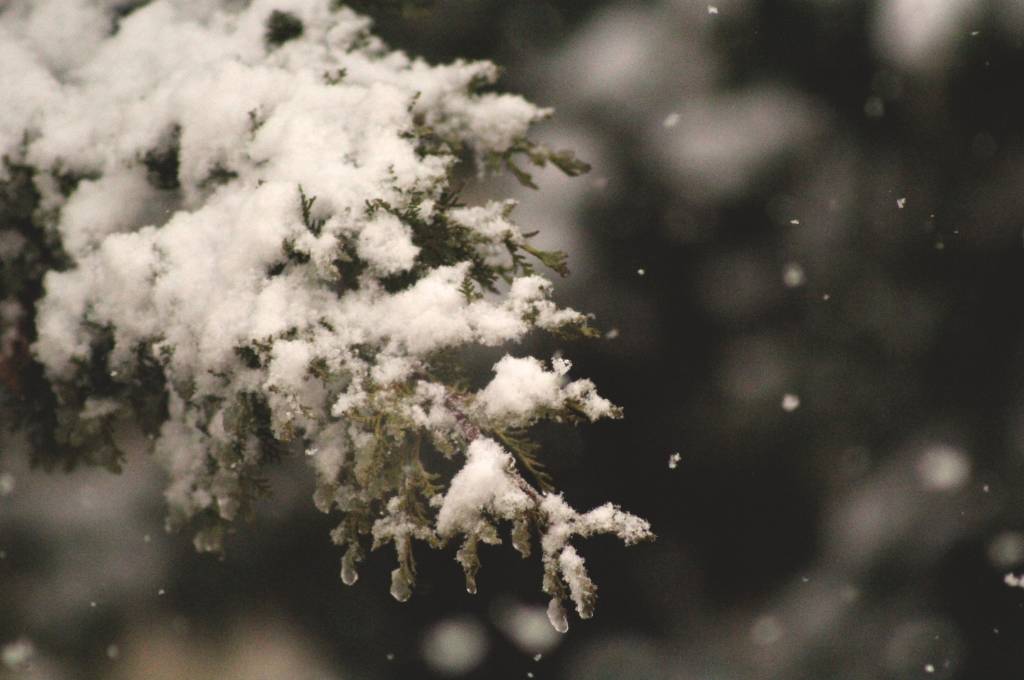
Extreme weather including heavy snowfall can cause the development of tree cracks.
Impact of Extreme Weather Conditions Can Cause Tree Cracks
Extreme weather conditions can cause tree cracks. When the weather becomes extreme, such as during strong storms or freezing temperatures, your trees are at risk of developing cracks. The impact of these weather conditions can be significant and should not be taken lightly.
During storms, strong winds can put immense pressure on the branches and trunk of your trees. The force of the wind can cause the wood to bend and flex, leading to cracks. Additionally, heavy rain can saturate the soil around the tree, causing it to become unstable and more susceptible to damage. If the tree is already weak or compromised, the combination of wind and rain can lead to cracks forming.
In freezing temperatures, the moisture inside the tree can freeze and expand, putting pressure on the wood. This expansion can cause the tree to crack, especially if it is already stressed or weakened. Cold temperatures can also make the tree more brittle, increasing the likelihood of cracks.
To prevent cracks caused by extreme weather conditions, it is important to regularly assess the health and stability of your trees. Pruning dead or weak branches can help reduce the risk of damage during storms. Additionally, providing proper care and maintenance, such as watering and fertilizing, can improve the overall health and resilience of your trees.
Remember, being proactive in protecting your trees from extreme weather conditions can help prevent cracks and ensure their longevity and beauty in your Massachusetts landscape.
Infestation by Pests and Insects Can Cause Tree Cracks
You might notice cracks in your Massachusetts trees due to an infestation by pests and insects. These tiny creatures can cause significant damage to the health and structure of your trees, leading to the formation of cracks.
Here are three ways pests and insects can contribute to the cracking of Massachusetts trees:
- Boring Insects: Certain insects, such as beetles and borers, bore into the wood of trees, creating tunnels and weakening their structure. As a result, the affected areas may develop cracks over time.
- Sap-Sucking Pests: Pests like aphids and scale insects feed on the sap of trees, depriving them of essential nutrients. This weakens the tree’s defense mechanisms, making it more susceptible to cracks and other types of damage.
- Wood-Destroying Insects: Termites and carpenter ants are notorious for their ability to consume wood. When they infest a tree, they can cause extensive damage, ultimately leading to the formation of cracks.
It is crucial to address pest and insect infestations promptly to prevent tree cracks. Regular inspections by arborists and implementing appropriate pest control measures can help mitigate the risk of cracks caused by these tiny invaders.
Remember, a healthy tree is less likely to succumb to infestations and subsequent cracking, so proper care and maintenance are essential.
Common Tree Diseases in Massachusetts
One common tree disease in Massachusetts is Dutch elm disease. It can cause significant damage to the elm population. Dutch elm disease is caused by a fungus called Ophiostoma ulmi, which is spread by the elm bark beetle. The disease affects the water-conducting vessels in the tree, leading to wilting, yellowing, and eventual death of the tree.
Another prevalent tree condition in Massachusetts is oak decline, sometimes caused by a fungus called Ceratocystis fagacearum. This disease primarily affects oak trees and is transmitted through root grafts or sap-feeding beetles. The fungus disrupts the tree’s water-conducting system, resulting in leaf discoloration, wilting, and death.
Massachusetts is also prone to beech bark disease. It is caused by a combination of a scale insect and a fungus. The scale insect, Cryptococcus fagisuga, feeds on the tree’s sap, while the fungus, Nectria coccinea, infects the tree through the wounds created by the scale insect. This disease leads to the degradation of the tree’s bark and can result in tree mortality.
Other common tree diseases in Massachusetts include apple scab, fire blight, and pine needle blight. These diseases can cause leaf discoloration, defoliation, and dieback, impacting the overall health and appearance of the trees.
To protect the Massachusetts tree population from these diseases, it is important to practice good tree care. This includes regular inspections, proper pruning techniques, and prompt treatment of any signs of disease or tree cracks. Additionally, preventing the spread of pests and insects that carry these diseases is crucial to maintaining the health of the trees.
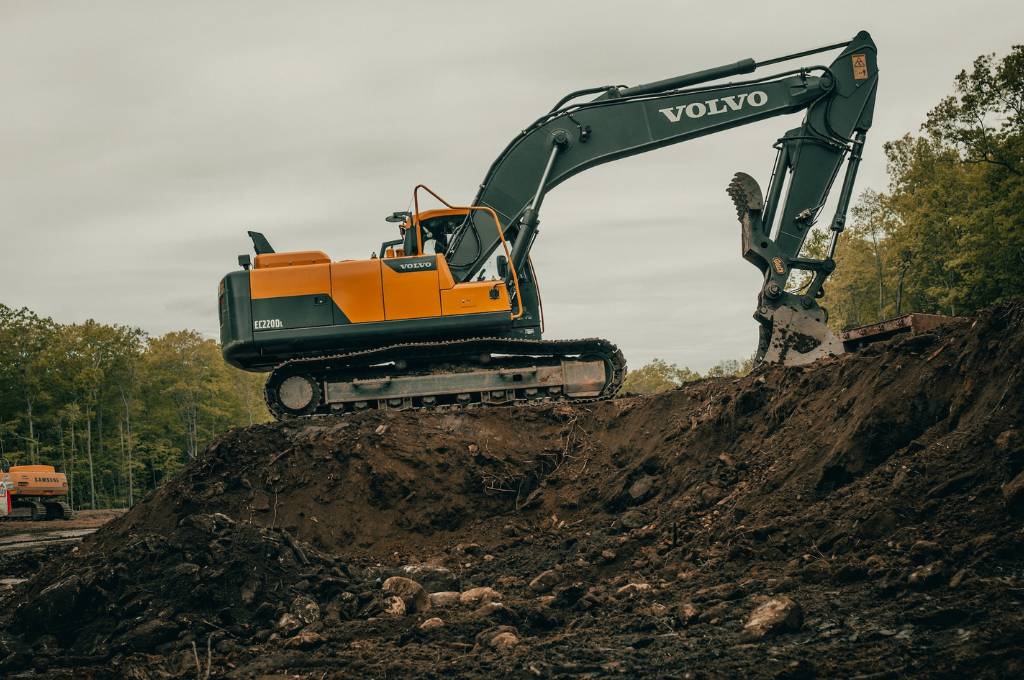
Heavy equipment excavation is one-way human activity can damage trees.
Human Activities and Tree Cracks
To prevent further damage to the trees, it’s important to be mindful of human activities that can harm them.
Trees in Massachusetts are often subjected to various forms of damage caused by human activities. One common way trees can be harmed is through improper pruning. When trees are pruned incorrectly, it can result in wounds that leave them vulnerable to disease and pests. It’s crucial to hire a certified arborist who knows how to prune trees properly.
Another activity that can harm trees is construction and excavation work. Heavy machinery and equipment can compact the soil around the tree’s roots, limiting its access to nutrients and water. To minimize damage, it’s essential to create protective barriers around the tree and avoid unnecessary disturbance to the roots.
Furthermore, the use of herbicides and pesticides can also harm trees. Chemicals that are sprayed near trees can be absorbed by the roots, causing damage to the tree’s overall health. It’s advisable to use organic alternatives or consult with a professional to determine the best approach for pest control.
By being aware of these human activities and taking necessary precautions, we can ensure the health and longevity of Massachusetts trees.
Preventive Measures for Preventing Tree Cracks
Take the necessary steps to maintain the health of your trees by implementing preventive measures. By doing so, you can ensure that your Massachusetts trees remain strong and resilient, with minimal cracks and damage.
One important preventive measure is regular pruning. Pruning helps remove dead or diseased branches, allowing for better air circulation and reducing the risk of cracks caused by weak or crowded branches. Additionally, pruning can help maintain the overall shape and structure of your trees, promoting their health and longevity.
Another vital preventive measure is providing proper irrigation. Adequate water supply is crucial for tree health, especially during dry periods. Ensure that your trees receive enough water, either through natural rainfall or manual watering, to prevent dehydration and the development of cracks due to drought stress.
Furthermore, applying mulch around the base of your trees can provide several benefits. Mulch helps retain moisture in the soil, prevents weed growth, and regulates soil temperature. By creating an optimal environment for your trees’ roots, you can reduce the risk of cracks caused by dry soil or extreme temperature fluctuations.
Lastly, be mindful of potential mechanical damage. Avoid hitting or scraping your trees with lawnmowers or other equipment, as this can lead to cracks and wounds that make them more susceptible to disease and pests.
By implementing these preventive measures, you can significantly reduce the likelihood of cracks in your Massachusetts trees and ensure their long-term health and vitality.
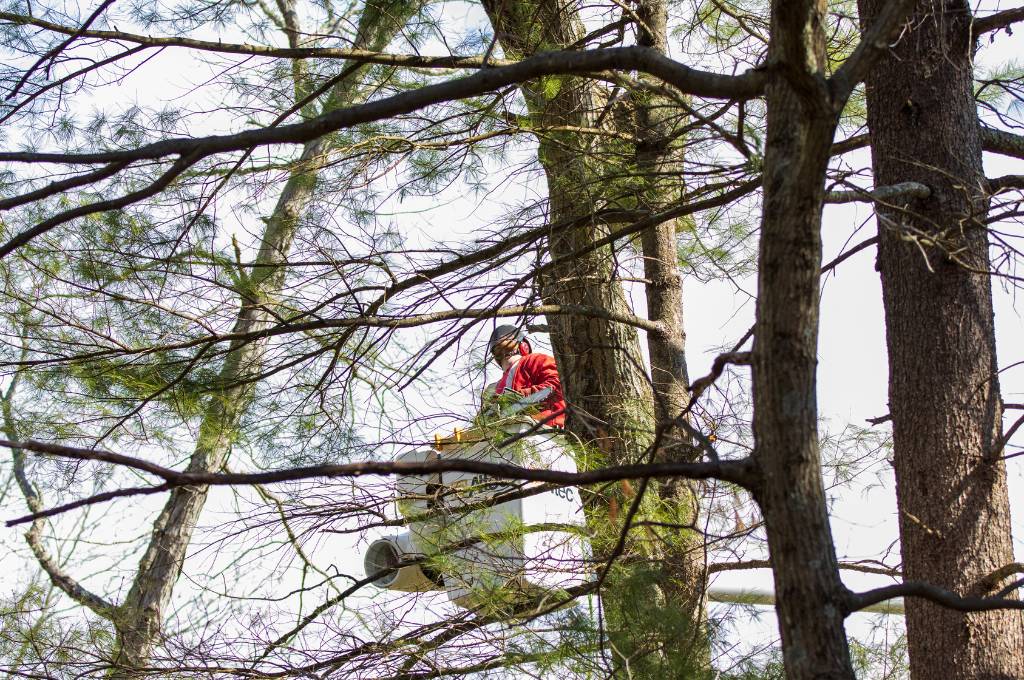
Maintenance pruning can help prevent situations that will result in limbs, branches, and trunks cracking.
Frequently Asked Questions
Can cracks in trees be caused by natural aging and growth?
Yes, cracks in trees can be caused by natural aging and growth. As trees mature, their trunks expand and contract, which can lead to the formation of cracks. This is a normal part of the tree’s development.
How can I determine if a crack in my tree is serious and requires professional attention?
To determine if a crack in your tree requires professional attention, closely inspect its size, location, and depth. If it’s large, near the base, or goes deep into the trunk, it’s best to call a professional arborist for assessment and potential treatment.
Are there any specific tree species in Massachusetts that are more prone to developing cracks?
Some tree species in Massachusetts are more prone to developing cracks. It’s important to identify the specific species in your area and be aware of their vulnerability to cracking.
Can cracks in trees heal on their own over time?
Yes, SOME cracks in trees can heal on their own over time. As the tree grows, it can produce new layers of wood that help to repair and close the cracks.
What are some signs of potential structural weakness in a tree that may lead to cracks?
Look for signs like leaning, splitting, or decayed areas on the trunk. These may indicate structural weakness and potential for cracks in your tree. Act promptly to prevent further damage or hazards.
Have Cracked Trees?
Call American Climbers today at 508-497-8628. Let us assess your cracked trees to determine the cause and the best course of action, whether it’s a removal or something else! We’re there when you need us!
Blog Topics
Recent Posts
What's Happening? Stay Informed!
Stay on top of local events, pest and disease updates, tree and landscape tips, and more. Delivered straight to your inbox each month.

